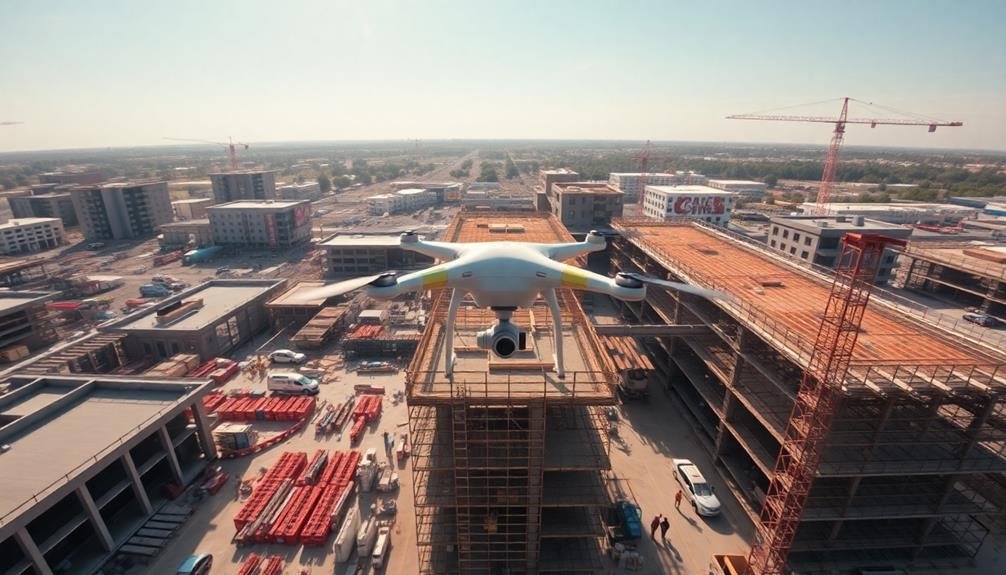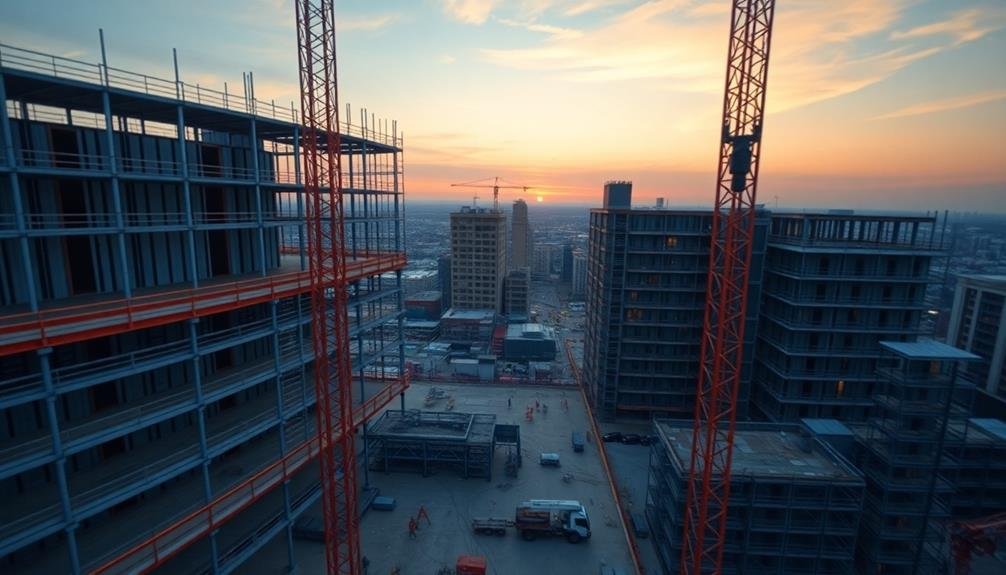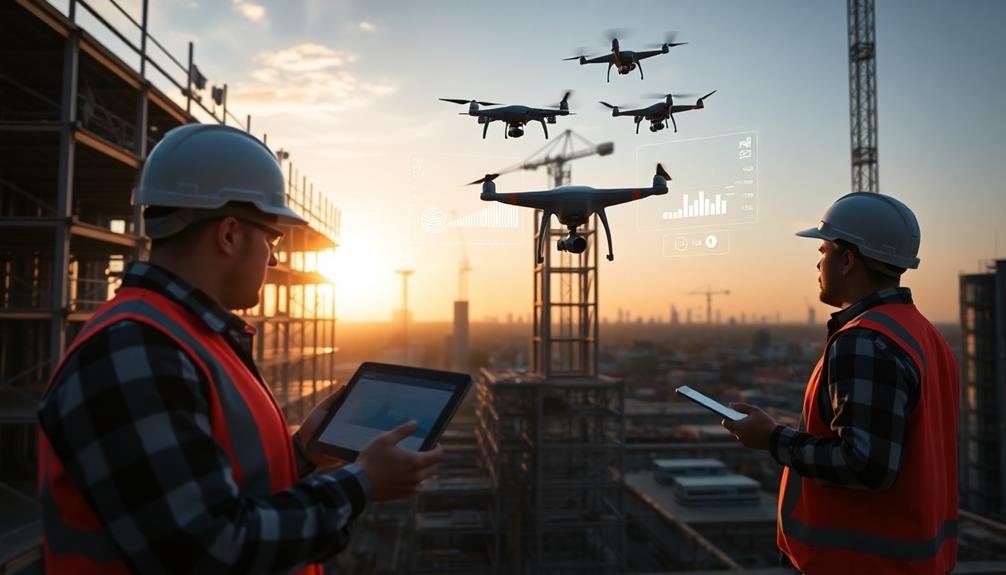You can revolutionize your construction site monitoring with these five smart tracking methods. Use aerial drone surveys for extensive bird's-eye views and detailed imagery. Implement time-lapse photography to spot issues and monitor workflow efficiency. Utilize 3D modeling and mapping for interactive project stage representations. Employ real-time data collection through IoT sensors and mobile apps for minute-by-minute progress tracking. Integrate progress reporting software to streamline data analysis and provide customizable dashboards. These cutting-edge techniques offer unparalleled insights into your project's status, enhancing communication and decision-making. Discover how these tools can transform your construction management approach.
Key Takeaways
- Utilize aerial drone surveys for comprehensive site monitoring and high-resolution imagery.
- Implement time-lapse photography to capture project progress over extended periods.
- Employ 3D modeling and mapping for detailed, interactive representations of construction stages.
- Deploy real-time data collection systems using IoT sensors and mobile apps for minute-by-minute tracking.
- Integrate progress reporting software for streamlined data analysis and customizable stakeholder dashboards.
Aerial Drone Surveys

Aerial drone surveys have revolutionized construction site monitoring. They provide a bird's-eye view of your project, allowing you to track progress, identify issues, and make informed decisions quickly. You'll get high-resolution images and videos that capture every detail of your site.
With drones, you can conduct regular surveys without disrupting work or compromising safety. You'll save time and resources compared to traditional ground-based surveys. Drones can access hard-to-reach areas, giving you an extensive view of your entire project.
You can use drone data to create 3D models, topographic maps, and volumetric measurements. This information helps you track earthwork progress, verify material quantities, and monitor stockpiles. You'll also be able to compare actual progress against your project timeline and identify potential delays early.
Drones equipped with thermal cameras can detect heat signatures, helping you identify potential issues like insulation problems or equipment overheating. You can also use drones for site security, monitoring for unauthorized access or equipment theft.
To get started, you'll need a licensed drone pilot and appropriate software to process and analyze the data. Make sure you comply with local regulations and obtain necessary permits for drone operations.
Time-Lapse Photography

Over time, time-lapse photography has emerged as a powerful tool for tracking construction site progress. By capturing images at regular intervals and compressing them into a video, you'll get a condensed view of your project's evolution. This method allows you to spot potential issues, monitor workflow efficiency, and showcase progress to stakeholders.
To implement time-lapse photography effectively, you'll need to strategically place high-quality cameras around your site. Choose weatherproof models with ample storage and power options. Set up multiple angles to capture different aspects of the construction process. You can opt for fixed cameras or mobile units that can be repositioned as needed.
When configuring your time-lapse setup, consider factors like interval frequency and duration. For long-term projects, daily or hourly captures might suffice, while shorter-term tasks may require more frequent shots. Use specialized software to compile and edit your footage, adding timestamps or annotations for clarity.
Time-lapse photography not only serves as a valuable tracking tool but also creates compelling visual content for marketing and documentation purposes. It's an efficient way to demonstrate your team's progress and maintain transparency throughout the construction process.
3D Modeling and Mapping

Leveraging cutting-edge technology, 3D modeling and mapping have revolutionized construction site progress tracking. You can now create detailed, interactive representations of your project at various stages of completion. These models provide a thorough view of the site, allowing you to identify potential issues and make informed decisions quickly.
To implement 3D modeling, you'll need to gather data using drones, laser scanners, or photogrammetry. Once collected, specialized software processes this information to generate accurate 3D models. These models can be updated regularly, giving you a clear picture of progress over time.
You'll find that 3D models offer several advantages. They enable remote site inspections, reducing the need for frequent on-site visits. You can easily compare actual progress to planned timelines, helping you identify delays or areas that need attention.
Additionally, these models facilitate better communication with stakeholders, as you can visually demonstrate progress and explain complex aspects of the project.
Real-Time Data Collection

Through real-time data collection, you can stay on top of your construction project's progress minute by minute. This approach involves using various technologies to gather and transmit data from the job site instantly. You'll be able to make informed decisions quickly and address issues as they arise.
One effective method is using IoT sensors to monitor equipment usage, material consumption, and environmental conditions. These sensors can send data to a central system, allowing you to track productivity and identify potential bottlenecks.
Another powerful tool is mobile apps that enable workers to report progress, submit time sheets, and document safety incidents in real-time.
Drones equipped with cameras can provide aerial footage and thermal imaging, giving you a thorough view of the site. This data can be used to assess progress, identify safety hazards, and plan future work.
Additionally, wearable technology like smart helmets can track worker location and crucial signs, enhancing safety and efficiency.
Progress Reporting Software Integration

Progress reporting software integration is the third key component in effectively tracking construction site progress. By integrating specialized software into your workflow, you'll streamline data collection, analysis, and reporting processes. This integration allows you to consolidate information from various sources, providing a thorough overview of your project's status.
Choose software that offers customizable dashboards, real-time updates, and mobile accessibility. These features enable you to monitor progress anytime, anywhere, and make informed decisions quickly. Look for solutions that integrate with your existing project management tools to guarantee seamless data flow and reduce duplicate entries.
| Feature | Benefit |
|---|---|
| Customizable dashboards | Tailored views for different stakeholders |
| Real-time updates | Immediate insight into project status |
| Mobile accessibility | On-the-go monitoring and reporting |
When selecting progress reporting software, consider its compatibility with BIM (Building Information Modeling) and other construction-specific technologies. This integration will help you visualize progress in 3D models, compare actual progress to planned schedules, and identify potential issues before they escalate.
Frequently Asked Questions
How Can Weather Conditions Affect Construction Site Progress Tracking Methods?
Weather conditions can greatly impact your construction site progress tracking. You'll need to factor in delays from rain, snow, or extreme temperatures. It's essential you adapt your methods to account for these unpredictable elements.
What Are the Legal Considerations for Implementing Tracking Technologies on Construction Sites?
You'll need to take into account privacy laws, data protection regulations, and worker consent. Make certain you're compliant with labor laws and union agreements. Don't forget to address potential liability issues related to tracking technologies on your construction site.
How Do You Ensure Data Security When Using Digital Progress Tracking Tools?
To guarantee data security with digital tracking tools, you'll need to implement strong encryption, use secure cloud storage, limit access with robust authentication, regularly update software, train employees on cybersecurity best practices, and perform routine security audits.
What Training Is Required for Staff to Effectively Use Progress Tracking Technologies?
You'll need to train your staff on the specific software or tools you're using. Focus on teaching data input, analysis, and reporting. Make certain they understand privacy protocols and how to troubleshoot common issues. Hands-on practice is essential.
How Can Progress Tracking Methods Be Adapted for Underground or Interior Construction Work?
You can adapt progress tracking for underground or interior work by using specialized sensors, RFID tags, and 3D scanning. You'll also need to employ wireless mesh networks for connectivity and rely more on wearable devices for data collection.
In Summary
You've now got five powerful tools to revolutionize your construction site progress tracking. By implementing aerial drone surveys, time-lapse photography, 3D modeling, real-time data collection, and progress reporting software, you'll gain unprecedented insights into your project's status. These methods will help you stay on schedule, identify potential issues early, and make informed decisions. Don't hesitate to embrace these technologies – they'll streamline your processes and boost your team's efficiency. Start implementing them today and watch your project thrive.

As educators and advocates for responsible drone use, we’re committed to sharing our knowledge and expertise with aspiring aerial photographers.




Leave a Reply